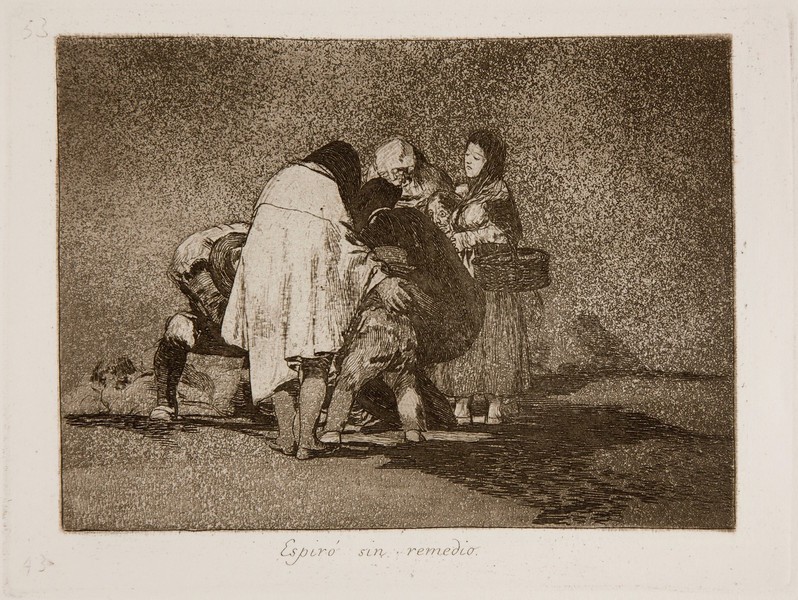- Cronología
- Ca. 1812 - 1815
- Dimensiones
- 156 x 209 mm
- Técnica y soporte
- Aguafuerte, lavis, aguatinta bruñida, buril y bruñidor
- Reconocimiento de la autoría de Goya
- Undisputed work
- Ficha: realización/revisión
- 16 Dec 2012 / 24 May 2023
- Inventario
- 225
43 (on the lower left-hand corner of the plate).
See Sad presentiments of what must come to pass.
The title was handwritten on the print by Goya in the first and only series that is known to have been printed at the time the works were created, which the artist gave to his friend Agustín Ceán Bermúdez. Therefore, the title was etched into the plate at a later date and left unchanged as of the first edition of the Disasters of War printed by the San Fernando Royal Academy of Fine Arts in Madrid in 1863, after the printing of the series in the possession of Ceán Bermúdez.
There is a surviving preparatory drawing for this print which is housed in the Prado Museum in Madrid.
In the centre of this print a group of people is gathered around someone who, as the work's title indicates, has just died. Two of the group have their backs to the viewer, while a third kneels down, perhaps in an attempt to help, and in the background two old women contemplate the scene. Next to the old women is a younger woman who is carrying a basket.
The highly granulated texture afforded by the use of aquatint on the entire background and a large part of the floor gives the scene an unreal air. There are no references in the work that allow the viewer to work out the time of day or location where this event is taking place. Goya has used this device before, in print no. 50 Unhappy mother! (Madre infeliz!), in which the artist also omits all spatial references.
In this print Goya continues to explore the grave consequences of the famine that ravaged the population during the Spanish War of Independence.
The plate is stored in the National Chalcography (cat. 304).
-
Francisco de GoyaMuseo d'Arte ModernaLugano1996exhibition celebrated from September 22nd to November 17th.cat. 53
-
Francisco Goya. Sein leben im spiegel der graphik. Fuendetodos 1746-1828 Bordeaux. 1746-1996Galerie KornfeldBern1996from November 21st 1996 to January 1997cat. 137
-
Francisco Goya. Capricci, follie e disastri della guerraSan Donato Milanese2000Opere grafiche della Fondazione Antonio Mazzottacat. 123
-
Goya. Opera graficaPinacoteca del Castello di San GiorgioLegnano2006exhibition celebrated from December 16th 2006 to April 1st 2007cat. 304
-
Goya et la modernitéPinacothèque de ParisParís2013from October 11st 2013 to March 16th 2014cat. 92
-
2022
-
Goya, grabadorMadridBlass S.A.1918cat. 155
-
Goya engravings and lithographs, vol. I y II.OxfordBruno Cassirer1964cat. 173
-
Vie et ouvre de Francisco de GoyaParísOffice du livre1970cat. 1080
-
Catálogo de las estampas de Goya en la Biblioteca NacionalMadridMinisterio de Educación y Cultura, Biblioteca Nacional1996cat. 262
-
ParísPinacoteca de París2013p. 146
-
Goya. In the Norton Simon MuseumPasadenaNorton Simon Museum2016pp. 114-151
-
Museo de Bellas Artes de Badajoz y Diputación de Badajoz2022p. 74

